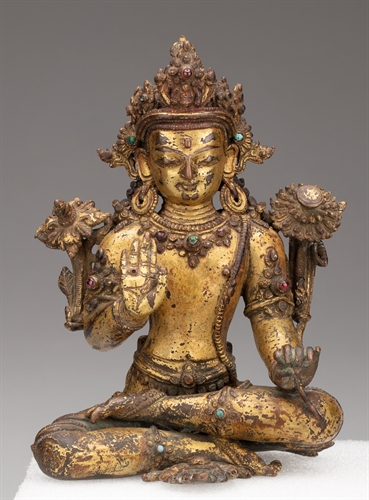The Buddhist Thangkas – Artistic Expression as Spiritual Path
Popular Tags

Wednesday, April 17, 2024 in Fine Art
Throughout the Himalayas, the vast mountain range spanning India, Nepal, Tibet and Bhutan, lies a vibrant artistic tradition: the creation of thangkas. Tibetan Buddhist paintings in particular are more than just decorative pieces, but represent windows into the soul of Vajrayana Buddhism. Thangkas, traditionally made on cotton or silk, are intricate and colorful depictions of deities, scenes from Buddhist stories, or the sacred diagrams known as mandalas.
A Path Through Colors and Symbols
Thangkas, unlike Western paintings, are not only appreciated for their beauty. From the vibrant colors to the specific gestures of a hand, Thangkas contain symbolic meaning. Details such as these act as a visual guide for meditation, allowing practitioners to focus and connect with the spiritual realm.
A Pantheon on Cloth
The Buddhist thangkas encompass a wide range of subjects from the diaspora that is Buddhism. Buddhas, serene figures representing enlightenment; Bodhisattvas, often depicted offering compassion and guidance on the path to enlightenment; and are also popular subjects; and wrathful deities from the practice of Vajrayana Buddhism, seen with fierce expressions and postures, meant to ward off negativity and protect practitioners.
The Art of Creation
Thangka creation is a meticulous process passed down through generations. Artists employ age-old techniques to produce vibrant colors using natural pigments derived from minerals and plants. The composition follows strict guidelines, ensuring the proper portrayal of postures, mudras (hand gestures), and other symbolic elements.
Not Just a Painting
Thangkas are used in various religious ceremonies, and therefore are not simply works of art to be displayed on walls. They are displayed in both homes and monasteries as devotional objects. They serve as a focal point for meditation, guiding practitioners to visualize deities and internalize their qualities and teachings.
A Glimpse into Himalayan Culture
Thangka paintings offer a unique perspective into the cultural and spiritual life of the Himalayan people. By studying these artworks, we gain a deeper understanding of Vajrayana Buddhist beliefs and how they are practiced. The enduring tradition of thangka creation ensures that this vibrant art form continues to illuminate the path to enlightenment for generations to come.
Where to Learn More
If you are interested in learning more about thangkas, several resources are available. ISA hosted a webinar titled "Putting a Price on Nirvana" by Miranda Ferries of The Art Institute in Chicago. In addition, the Rubin Museum of Art in New York and the Tibet House Museum in New Delhi house impressive collections of Himalayan art, including thangkas. Additionally, the informative website of the Himalayan Art Resources https://www.himalayanart.org/ offers a wealth of information on this fascinating artistic tradition.
